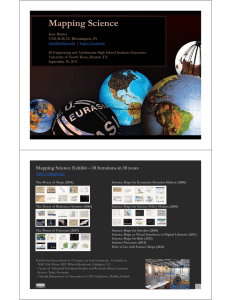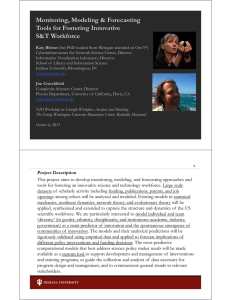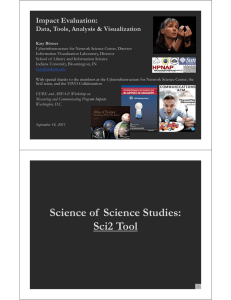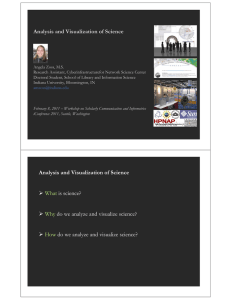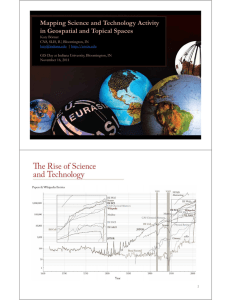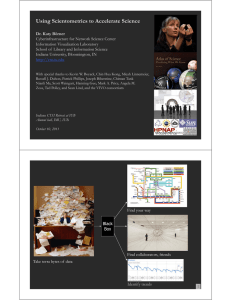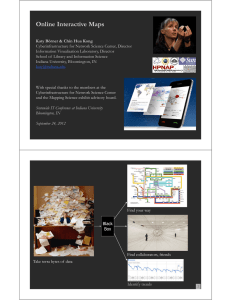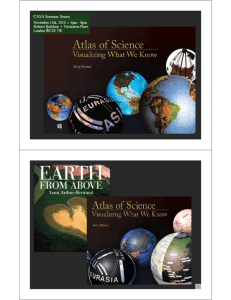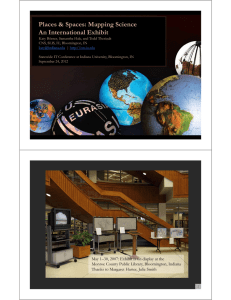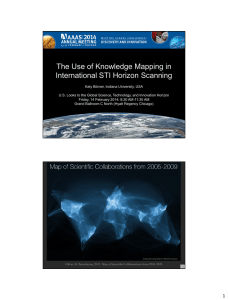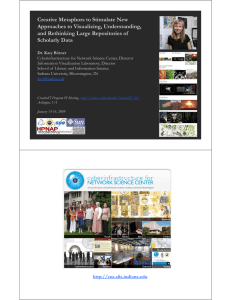Envisioning Scholarly Data
advertisement
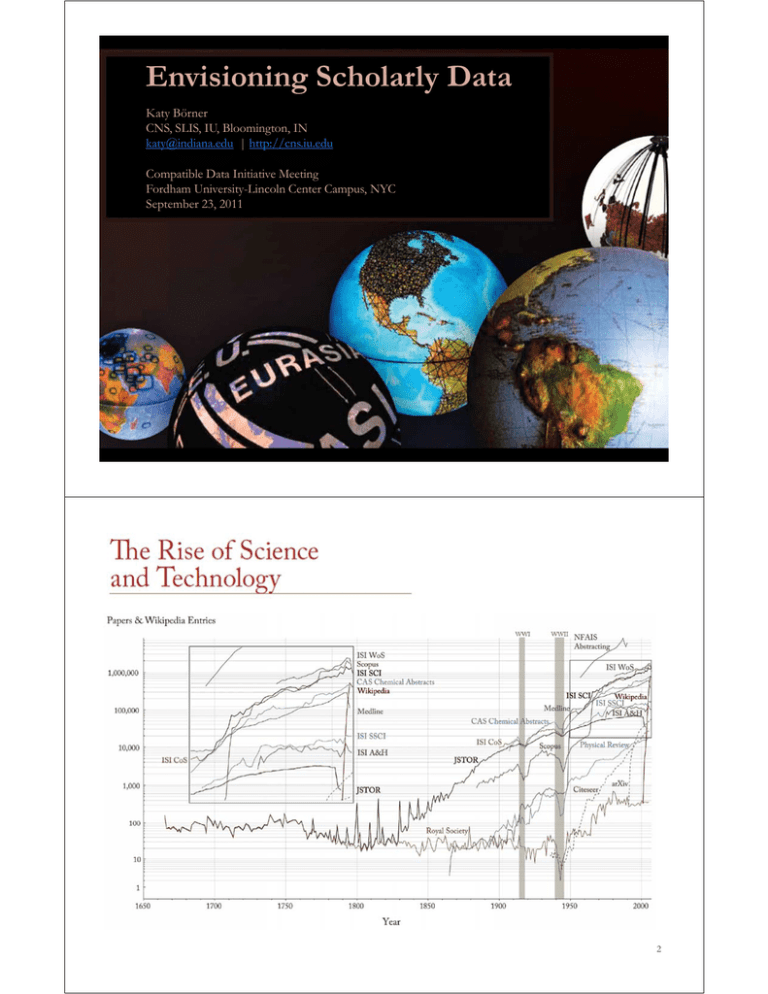
Envisioning Scholarly Data Katy Börner CNS, SLIS, IU, Bloomington, IN katy@indiana.edu | http://cns.iu.edu Compatible Data Initiative Meeting Fordham University-Lincoln Center Campus, NYC September 23, 2011 2 3 4 August 2007 Linked Open Data Interlinks existing data silos and Exposes them as structured and high quality data http://linkeddata.org 5 2005 World Population The population map uses a quarter degree box resolution. Boxes with zero people are given in white. Darker shades of red indicate higher population counts per box using a logarithmic interpolation. The highest density boxes appear in Mumbai, with 11,687,850 people in the quarter degree block, Calcutta (10,816,010), and Shanghai (8,628,088). 6 2007 IP Address Ownership This map shows IP address ownership by location. Each owner is represented by a circle and the area size of the circle corresponds to the number of IP addresses owned. The larges circle denotes MIT’s holdings of an entire class A subnet, which equates to 16,581,375 IP addresses. The countries that own the most IP addresses are US (560 million), Japan (130 million), Great Britain (47 million). 7 2003 Scientific Productivity Shown is where science is performed today. Each circle indicates a geographic location at which scholarly papers are published. The larger the circle the more papers are produced. Boston, MA, London, England, and New York, NY are the top three paper production areas. Note the strong resemblance with the Night on Earth and the IP Ownership maps and the striking differences to the world population map. 8 2000 Night on Earth This image shows city lights at night. It was composed from hundreds of pictures made by orbiting satellites. The seaboards of Europe, the eastern United States, and Japan are particularly well lit. Many cities exist near rivers or oceans so that goods can be exchanged cheaply by boat. The central parts of South America, Africa, Asia, and Australia are rather dark despite their high population density, see map to the left. 9 Type of Analysis vs. Level of Analysis Micro/Individual (1-100 records) Meso/Local (101–10,000 records) Macro/Global (10,000 < records) Statistical Analysis/Profiling Individual person and their expertise profiles Larger labs, centers, universities, research domains, or states All of NSF, all of USA, all of science. Temporal Analysis (When) Funding portfolio of one individual Mapping topic bursts in 20-years of PNAS 113 Years of Physics Research Geospatial Analysis (Where) Career trajectory of one individual Mapping a states intellectual landscape PNAS publciations Topical Analysis (What) Base knowledge from which one grant draws. Knowledge flows in Chemistry research VxOrd/Topic maps of NIH funding Network Analysis (With Whom?) NSF Co-PI network of one individual Co-author network NIH’s core competency 10 Plug-and-Play Macroscopes While microscopes and telescopes are physical instruments, macroscopes resemble continuously changing bundles of software plug-ins. Sharing algorithm components, tools, or novel interfaces becomes as easy as sharing images on Flickr or videos on YouTube. Assembling custom tools is as quick as compiling your custom music collection. They provide a common standard for the design of modular, compatible algorithm and tool plug-ins that can be easily combined into scientific workflows, and packaged as custom tools. Börner, Katy. (2011). Plug-and-Play Macroscopes. Communications of the ACM, 54(3), 60-69. Video is at http://www.scivee.tv/node/27704 11 Sci2 Tool – “Open Code for S&T Assessment” http://sci2.cns.iu.edu OSGi/CIShell powered tool with NWB plugins and many new scientometrics and visualizations plugins. Sci Maps GUESS Network Vis Horizontal Bar Graphs Börner, Katy, Huang, Weixia (Bonnie), Linnemeier, Micah, Duhon, Russell Jackson, Phillips, Patrick, Ma, Nianli, Zoss, Angela, Guo, Hanning & Price, Mark. (2009). Rete-Netzwerk-Red: Analyzing and Visualizing Scholarly Networks Using the Scholarly Database and the Network Workbench Tool. Proceedings of ISSI 2009: 12th International Conference on Scientometrics and Informetrics, Rio de Janeiro, Brazil, July 14-17 . Vol. 2, pp. 619-630. Timeline Visualization: Example 13 Sci2 Tool Geo Maps Circular Hierarchy http://sci2.cns.iu.edu http://sci2.wiki.cns.iu.edu 15 Needs-Driven Workflow Design using a modular data acquisition/analysis/ modeling/ visualization pipeline as well as modular visualization layers. Börner, Katy (2010) Atlas of Science. MIT Press. 16 Network Extraction: Examples Author co-occurrence network Paper-author 2-mode network 17 Network Visualization: Example 18 Network Visualization: Example 19 Sci2 Tool Adoption The Sci2 Tool is used by NSF, NIH, USDA, and private foundations. Upcoming Tutorial: Sci2: A Tool of Science of Science Research and Practice Instructor: Time/Date: Place: Audience: Cost: Register: Dr. Katy Börner, Indiana University 8:30a-11:30a on Oct 17, 2011 Room II-555 in NSF's Stafford Place II Conference Center, 4121 Wilson Boulevard, Arlington, Virginia 22230, USA This tutorial is designed for researchers, practitioners, program staff from federal agencies interested to use advanced data mining algorithms and visualizations in their work and daily decision making. Free. Registration by Oct 10, 2011 required. Please use http://www.surveymonkey.com/s/MVC8LWW to register by Oct 10, 2012. NSF will issue visitor badges. 20 21 27 31 32 33 34 35 Science as accumulation of knowledge. Areas of science are tube shaped. Authors are mortal. Papers are immortal. “Scholarly brick laying”. Monsters = ‘the or of voids. onunknown’ the shoulders of giants. This drawing attempts toStanding shows the “structure” science. Crust of science “funding” or “usage”. Impactcan of represent funding on science (yellow). and badknit years. Densely Many are interestedGood to understand thecommunities. “dynamics” of science. The importance of weak links. Hypothetical Model of the Evolution of Science - Daniel Zeller - 2007 41 42 Illuminated Diagram Display W. Bradford Paley, Kevin W. Boyack, Richard Kalvans, and Katy Börner (2007) Mapping, Illuminating, and Interacting with Science. SIGGRAPH 2007. Questions: Who is doing research on what topic and where? What is the ‘footprint’ of interdisciplinary research fields? What impact have scientists? Large-scale, high resolution prints illuminated via projector or screen. Interactive touch panel. Contributions: Interactive, high resolution interface to access and make sense of data about scholarly activity. 43 Science Maps in “Expedition Zukunft” science train visiting 62 cities in 7 months 12 coaches, 300 m long Opening was on April 23rd, 2009 by German Chancellor Merkel http://www.expedition-zukunft.de 44 Mapping Science Exhibit – 10 Iterations in 10 years http://scimaps.org/ The Power of Maps (2005) Science Maps for Economic Decision Makers (2008) The Power of Reference Systems (2006) Science Maps for Science Policy Makers (2009) The Power of Forecasts (2007) Science Maps for Scholars (2010) Science Maps as Visual Interfaces to Digital Libraries (2011) Science Maps for Kids (2012) Science Forecasts (2013) How to Lie with Science Maps (2014) Exhibit has been shown in 72 venues on four continents. Currently at - NSF, 10th Floor, 4201 Wilson Boulevard, Arlington, VA - Center of Advanced European Studies and Research, Bonn, Germany - Science Train, Germany - Cultural Dimensions of Innovation, UCD Conference, Dublin, Ireland 45 Bollen, Johan, Herbert Van de Sompel, Aric Hagberg, Luis M.A. Bettencourt, Ryan Chute, Marko A. Rodriquez, Lyudmila Balakireva. 2008. A Clickstream Map of Science. 46 Council for Chemical Research. 2009. Chemical R&D Powers the U.S. Innovation Engine. Washington, DC. Courtesy of the Council for Chemical Research. 47 48 Cesar A. Hidalgo, Bailey Klinger, Albert-László Barabási , Ricardo Hausmann . 2007. The Product Space Adrian White and the National Geographic EarthPulse Team. 2008. A Global Projection of Subjective Well-being 49 50 Debut of 5th Iteration of Mapping Science Exhibit at MEDIA X was on May 18, 2009 at Wallenberg Hall, Stanford University, http://mediax.stanford.edu, http://scaleindependentthought.typepad.com/photos/scimaps 51 We would like to thank the map makers VIVO: A Semantic Approach to Creating a National Network of Researchers (http://vivoweb.org) • Semantic web application and ontology editor originally developed at Cornell U. • Integrates research and scholarship info from systems of record across institution(s). • Facilitates research discovery and crossdisciplinary collaboration. • Simplify reporting tasks, e.g., generate biosketch, department report. Funded by $12 million NIH award. Cornell University: Dean Krafft (Cornell PI), Manolo Bevia, Jim Blake, Nick Cappadona, Brian Caruso, Jon Corson-Rikert, Elly Cramer, Medha Devare, John Fereira, Brian Lowe, Stella Mitchell, Holly Mistlebauer, Anup Sawant, Christopher Westling, Rebecca Younes. University of Florida: Mike Conlon (VIVO and UF PI), Cecilia Botero, Kerry Britt, Erin Brooks, Amy Buhler, Ellie Bushhousen, Chris Case, Valrie Davis, Nita Ferree, Chris Haines, Rae Jesano, Margeaux Johnson, Sara Kreinest, Yang Li, Paula Markes, Sara Russell Gonzalez, Alexander Rockwell, Nancy Schaefer, Michele R. Tennant, George Hack, Chris Barnes, Narayan Raum, Brenda Stevens, Alicia Turner, Stephen Williams. Indiana University: Katy Borner (IU PI), William Barnett, Shanshan Chen, Ying Ding, Russell Duhon, Jon Dunn, Micah Linnemeier, Nianli Ma, Robert McDonald, Barbara Ann O'Leary, Mark Price, Yuyin Sun, Alan Walsh, Brian Wheeler, Angela Zoss. Ponce School of Medicine: Richard Noel (Ponce PI), Ricardo Espada, Damaris Torres. The Scripps Research Institute: Gerald Joyce (Scripps PI), Greg Dunlap, Catherine Dunn, Brant Kelley, Paula King, Angela Murrell, Barbara Noble, Cary Thomas, Michaeleen Trimarchi. Washington University, St. Louis: Rakesh Nagarajan (WUSTL PI), Kristi L. Holmes, Sunita B. Koul, Leslie D. McIntosh. Weill Cornell Medical College: Curtis Cole (Weill PI), Paul Albert, Victor Brodsky, Adam Cheriff, Oscar Cruz, Dan Dickinson, Chris Huang, Itay Klaz, Peter Michelini, Grace Migliorisi, John Ruffing, Jason Specland, Tru Tran, Jesse Turner, Vinay Varughese. Temporal Analysis (When) Temporal visualizations of the number of papers/funding award at the institution, school, department, and people level 54 Topical Analysis (What) Science map overlays will show where a person, department, or university publishes most in the world of science. (in work) 55 Network Analysis (With Whom?) Who is co-authoring, co-investigating, co-inventing with whom? What teams are most productive in what projects? 56 http://nrn.cns.iu.edu Geospatial Analysis (Where) Where is what science performed by whom? Science is global and needs to be studied globally. Science & Technology Forecasts @ Times Square in 2020 This is the only mockup in this slide show. Everything else is available today. 58 References Börner, Katy, Chen, Chaomei, and Boyack, Kevin. (2003). Visualizing Knowledge Domains. In Blaise Cronin (Ed.), ARIST, Medford, NJ: Information Today, Volume 37, Chapter 5, pp. 179-255. http://ivl.slis.indiana.edu/km/pub/2003-borner-arist.pdf Shiffrin, Richard M. and Börner, Katy (Eds.) (2004). Mapping Knowledge Domains. Proceedings of the National Academy of Sciences of the United States of America, 101(Suppl_1). http://www.pnas.org/content/vol101/suppl_1/ Börner, Katy, Sanyal, Soma and Vespignani, Alessandro (2007). Network Science. In Blaise Cronin (Ed.), ARIST, Information Today, Inc., Volume 41, Chapter 12, pp. 537607. http://ivl.slis.indiana.edu/km/pub/2007-borner-arist.pdf Börner, Katy (2010) Atlas of Science. MIT Press. http://scimaps.org/atlas Scharnhorst, Andrea, Börner, Katy, van den Besselaar, Peter (2011) Models of Science Dynamics. Springer Verlag. 59 All papers, maps, tools, talks, press are linked from http://cns.iu.edu CNS Facebook: http://www.facebook.com/cnscenter Mapping Science Exhibit Facebook: http://www.facebook.com/mappingscience
